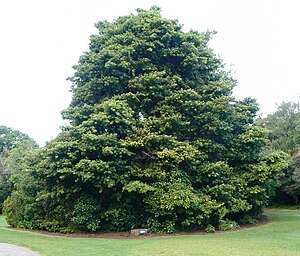Trees
Gold Wolf - Living with Nature: Describe the uses of trees. Take care of a tree for one month.
Trees are great!

Trees keep our environment healthy!
- Trees make the oxygen that we breathe! Trees breathe in carbon dioxide and breathe out oxygen.
- Tree roots hold the soil together and prevent soil erosion.
- Trees provide food and shelter for many different animals, birds and insects. Can you think of some?
- Leaves that fall from trees help become part of fertile soil.
- Leaves of trees clean polluted air.
Trees are useful!
- Many trees grow food that we can eat. Can you think of different foods and drinks we get from trees?
- Trees provide shade and protection from the wind.
- Wood from trees is used for buildings, furniture and many other uses.
- Wood from trees is also used to make paper.
- Trees provide fuel for cooking and heating.
Trees are fun!
- Trees are fun to explore and to climb.
- Trees are beautiful to look at.
How high is that tree?
Get someone, preferably a Scout, to give the Cubs a training session on height estimation and let them work out the height of the trees near your Pack meeting place.
Show them how to measure the size of the tree. Measure the tree by the distance from the tree until you can see it through your legs.
Uses of trees
- Challenge your Cubs, either those working on this activity, or the whole Pack in Sixes, to make charts on the uses of trees or on one specific tree if they have enough information on that tree.
Adopting a tree
Make sure you choose a tree you can observe regularly. Adopting a tree means making it YOUR special tree, not only learning about it but giving it water. Other ways you can care for a tree are keeping the area around it free of weeds and litter and giving it fertilizer to improve the soil. If the tree is in a garden or on a street and the branches are hanging too low or getting in the way of pedestrians, you can get an adult to help you trimming branches to keep the tree tidy.
To learn more about the tree, look at it carefully and then:
- Make a drawing of its shape
- Look at the bark - is it rough or smooth? (Akela will show you how to make a bark rubbing)
- Does it have flowers or fruit?
- Do birds like to visit the tree, and are there any nests in it?
- Look closer - are there insects on the tree, or perhaps moss or lichen?
- Try to find out the name of your tree.
- Is it an indigenous tree (native to South Africa)?
Bark and leaves
- Bark Rubbing: Have a sheet of plain white paper (not too thick) and a wax crayon or soft pencil for each Cub. Show them how to place the paper firmly against the tree trunk and rub the crayon backwards and forwards across the paper fairly evenly. The pattern of the bark will slowly appear on the paper.
- Leaf Prints: Here are two different methods, you probably have more ideas, so use them and perhaps also share them with us.
- Do a leaf rubbing by placing a piece of thin paper over the leaf and rubbing it gently with a wax crayon or soft pencil, as you did for the bark rubbings.
- Lay the chosen leaf on a piece of cardboard, with the vein side up. Take a can of coloured spray-paint and cover the leaf with paint. Remove the leaf and press the painted side onto a clean sheet of paper. Shoe polish or an ink pad can be used instead of the paint.
